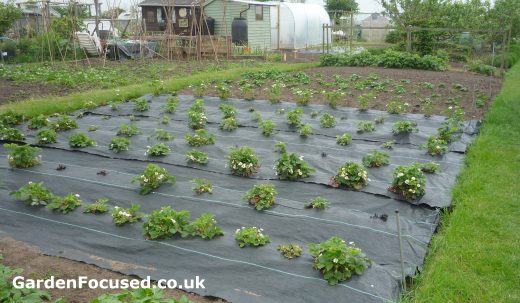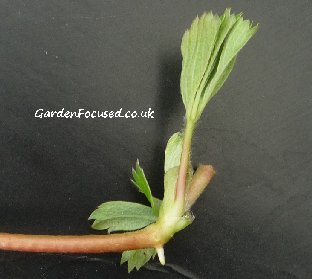CALENDAR |
WHICH VARIETY? |
SOIL & POSITION |
WHEN TO BUY? |
PLANTING |
CARE & HARVEST |
PEST & DISEASE |
PROPAGATION |
POTS, GROWBAGS |
As far as ongoing care is concerned, the points listed below are the main needs of strawberry plants. Each one is explained in more detail further down this page.
- Water in spring and up to harvest time is probably the most important need of strawberry plants.
- Fertilise with blood, fish and bone (a handful per square metre / yard) in March.
- Frost protection if a frost threatens when the strawberry flowers emerge in late spring.
- Straw or matting under growing fruits.
- Pruning of runners and leaves.
- Weeding is a key task to avoid the risk of fungal diseases
- Crop rotation every three or four years
WHEN AND HOW TO WATER STRAWBERRY PLANTS
When strawberry fruits are forming the plants need a constant supply of water to produce the largest fruits possible. There is a misconception however, that strawberry plants are shallow rooted, in fact the roots go as far down as 1m / 3ft which is surprising for a plant which stands less than 30cm / 1ft high. It is true though that the spread of the roots starts to lessen after they reach their maximum at 30cm / 1ft deep. The spread of the roots at 30cm / 1ft deep is about 60cm /2ft wide.
In most conditions strawberry plants grown in the open ground will not require watering, in fact watering may well harm them by increasing the risk of fungal diseases. There are some situations where water may be required and these are listed below:
- Drought conditions. If the weather is exceptionally dry and warm for a week or more, watering may be required. Other plants with less developed root systems will suffer before strawberry plants and these will be an indicator that water is required.
- Unusually light soils. If you have soil which drains very quickly water may be required more often compared to normal conditions.
- Raised beds and containers, especially hanging baskets are well-known for drying out quickly. The soil should be kept moist and not allowed to dry out. In warm summers hanging baskets may occasionally require watering twice a day.
FEEDING STRAWBERRY PLANTS
Although strawberries do benefit from a small amount of feeding, if the ground has been prepared correctly at planting time there is probably only a need for a handful of blood, fish and bone every square metre in March time. Avoid feeding your strawberry plants with a nitrogen rich feed, that will produce lush new foliage which will be susceptible to moulds and fungi. Strawberries really do prefer to be grown with minimal fertilisers if they are to grow healthily.
PROTECTING STRAWBERRY PLANTS FROM FROST
In the UK the only time your strawberry plants may benefit from protection from frost is in late spring, May time, when the flowers first open. Occasionally a hard frost can occur when the flowers are fully open and if this is the case, covering the plants at night time with horticultural fleece or similar will go a long way to reducing any damage. Be sure to remove the fleece during the day to avoid trapping moisture in around the foliage.
We don’t want to exaggerate the risk of frost though because strawberry plants are very hardy plants. It’s the flowers which are at risk of frost rather than the plants or the fruits. Here are a couple of statistics from some in depth research done by Virginia Tech which may help you assess the possible damage done by frost. The figures refer to radiation frost which means a frost with little or no wind, if there is a strong wind the damage thresholds are higher:
- Damage to fruits will occur at -2.2°C / 28°F, above that temperature they should be OK
- Damage to tight flower buds will only occur if the the temperature is below -5°C / 23°F
- Damage to buds which have swollen but are not yet open will be damaged by temperatures lower than -3°C / 27°F
- Damage to open flowers will occur when the temperature falls below -1°C / 30°F
The damage done by a frost below those temperatures is not total however, some flowers / fruits will be affected others won’t. The article we quote in the previous paragraph suggests common methods for frost protection when frosts threaten, so it may well be worth a read if you live in cooler parts of the UK. We were rather surprised at first that they recommend water sprinklers as the most common frost protection method for strawberries in industrial growing situations but further research we carried out backed this up.
STRAW UNDER DEVELOPING STRAWBERRY FRUITS
When strawberry fruits begin to develop and all danger of frost has passed place straw under the leaves of your plants to prevent the fruits resting on the ground. This will prevent fungi, moulds and other pests from spoiling the fruit. Don’t put the straw out too early because this will insulate the plants from the ground and make them more liable to frost damage.
When the fruit has been picked remove the straw to allow air to circulate and expose any pests below to birds which will eat them.
Another excellent alternative (see picture below) is weed proof matting. This accomplishes two jobs in one go. First it prevents the growth of weeds which can often be a major problem with strawberry beds. Second, it does the same job as straw by keeping the plants off the bare soil. The material shown in the picture is widely available at garden centres and diy store.

PRUNING STRAWBERRY PLANTS
Throughout the growing season strawberry plants will produce runners. These are one of the methods the plant uses to propagate itself but they do sap the energy of the parent plant. The picture below shows the end of a runner, the part which will root into the soil and produce a new plant.

Unless you want to propagate more strawberry plants these runners are best clipped off as near to the mother plant as possible.
When the plants finish cropping and you remove the straw, take a good look at the plants. You will notice that there are older, larger leaves which are growing outside the edge of the crown (centre) of the plant and other newer and smaller leaves growing 7cm to 10cm (3in to 4in) around the crown. As far as the plant is concerned the larger leaves serve a different purpose from the smaller, more central leaves. The larger leaves support the plant when it is producing fruit from late April up to the end of fruiting. After fruiting they serve no real purpose and are best removed. This will allow better air circulation and help reduce the risk of fungal infections.
Be very careful to leave the smaller, more central leaves because their purpose is to support the plant to produce the beginnings of the flowers which will appear next year. Around October time take another look at the plants and remove any damaged or decaying leaves.
During the year weed around the plants regularly. This will reduce competition for moisture and nutrients. It will also maintain an open atmosphere around the plants allowing plenty of air circulation.
CROP ROTATION FOR STRAWBERRY PLANTS
After three years of producing fruits, strawberry plants should be dug up and burnt. It may seem harsh to do this to plants which have cropped well but all strawberry plants, however well kept, will start to become significantly affected by diseases after three years of life. If you continue to grow them for a few years more not only will the crop reduce but the ground will become riddled with diseases.
Prepare another plot of land for new strawberry plants as described in the previous page here. The new plot of land will be in use growing strawberries for another three years and by that time it should be OK to use the original plot of land as long as it has not been used to grow plants which are prone to Verticillium Wilt such as tomatoes, peppers and potatoes.
WHEN TO HARVEST AND STORE STRAWBERRIES
Judging the very best time to harvest is an art rather than a science. The best approach is to use the variety name and find out a little more about when they are due for harvest in an average year and what colour they should be. Some strawberry varieties are a darker red compared to others and sizes vary considerably.
When you judge the time for harvest has arrived taste a couple and if they come up to expectations then begin to harvest. If they are not yet sweet then leave them for a few days. On average a particular variety will produce tasty and edible fruit over a period of about ten days to two weeks, after that time the fruits will begin to rot.
If you are harvesting strawberries into containers then only pile them two high, any more and the bottom layer can get squashed and damage the fruits. The best time to harvest strawberries is when the weather is dry and cool, early in the morning is the best time. Place the fruits in the refrigerator as soon as possible, they will store for two or three days. For the very best flavour, remove strawberries from the fridge an hour or so before eating, they are far more tasty at room temperature.
FIND OUT MORE ABOUT STRAWBERRIES BELOW
CALENDAR |
WHICH VARIETY? |
SOIL & POSITION |
WHEN TO BUY? |
PLANTING |
CARE & HARVEST |
PEST & DISEASE |
PROPAGATION |
POTS, GROWBAGS |
CARE OF SUMMER STRAWBERRY PLANTS
By David Marks
Strawberry plants are remarkably hardy and most of the time will look after themselves with very little attention. Even frosts are unlikely to damage them in our UK climate.
We list the seven key care tasks which will ensure a healthy crop each year. They are not complicated especially so when we describe them in detail using plain and simple language. The one to watch out for is crop rotation because this can prove problematic in smaller gardens but it is very necessary if you want to avoid the common pests and diseases.
Other pages on strawberries are shown below: